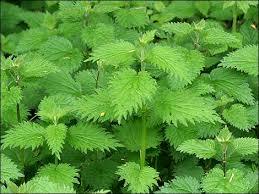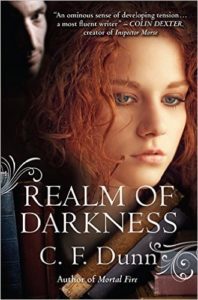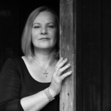C.F. Dunn's Blog, page 8
July 26, 2018
Latest 5* Book Review!
Look at this! Blogger Tamara Tilley has produced a wonderful series and book review of The Secret of the Journal series and Fearful Symmetry. If you’re looking for an immersive holiday read where past and present collide and nothing is what it seems, why not start with Book 1: Mortal Fire and start the journey today?
https://tamara-tilley.blogspot.com/2018/06/my-review-fearful-symmetry-by-cf-dunn.html
The post Latest 5* Book Review! appeared first on C.F.Dunn.
July 11, 2018
Breaking Ground
I’ve long dreamed of being almost self-sufficient in vegetables and fruit, and the clay ‘soil’ is the main reason why we are going to the expense and bother of building raised beds for the kitchen garden. The site is chock full of rubble bound together in a lumpy mass of rock hard clay. To get the fence posts in, the builders have had to use mechanical augers, and even those have struggled to make any impression. If digging the ground is unrealistic, these ‘sleepers’ should do the trick of creating workable areas of soil in which the plants can bury their roots and feed my family.
The post Breaking Ground appeared first on C.F.Dunn.
December 31, 2017
Happy New Year!
 For some, 2017 has been a bit of a trial, for others, a time of change. Whichever, whatever, thank you for your friendship and encouragement, and here’s wishing a happy and blessed 2018 to all.
For some, 2017 has been a bit of a trial, for others, a time of change. Whichever, whatever, thank you for your friendship and encouragement, and here’s wishing a happy and blessed 2018 to all.
November 8, 2017
Getting Out of the Rut: 12 Ways To Get Plotting
 Want to write a book but don’t know where to start? Here’s a list of 12 things I find useful when coming up with a new book project:
Want to write a book but don’t know where to start? Here’s a list of 12 things I find useful when coming up with a new book project:
1. Follow your dreams. There’s nothing quite like letting your mind wander to help find a new plot: (Not) listening to the football results, a lecture in earthworm politics, Aunt Agatha relating the latest price of cheese – not exactly riveting stuff, so when you next face a bored meeting, imagine what would happen if all of a sudden…
2. Pulling the trigger. Some things trigger ideas – like smells: the musty stone of a Medieval church; seaweed on a beach; a fresh-lit bonfire. See the changing seasons, or the dent on the bumper; hear the seagulls in the mist, or the lorry grind up the hill. Feel the brush of warm fur against your leg, the burning frost against your skin. Taste the first strawberry of summer, or the bitter aftertaste of something not quite right with the tea. We are bombarded with sensory information all the time – use it. And then there’s the sixth sense. That I leave to your vivid imaginations.
3. Mundane tasks like chopping veg; pulling weeds; polishing metal – require little thought. I get some of my best ideas preparing family meals. The family get fed and I get an idea for a new book.
4. Earthly delights: some festivals resonate with childhood memories and make the basis for a cracking seasonal book. I have a great story up my sleeve set in winter in Scotland that was the result of preparing a Christmas cake one year.
 5. My favourite things: back to those triggers again. Take a favourite or poignant keepsake – a childhood musical box, a shell picked from the edge of the sea, a pencil your best friend gave you before they went away – each could be the basis of a story.
5. My favourite things: back to those triggers again. Take a favourite or poignant keepsake – a childhood musical box, a shell picked from the edge of the sea, a pencil your best friend gave you before they went away – each could be the basis of a story.
6. Under the skin: I love portraits – old or new, paint, pencil or photograph, there is nothing quite like capturing a moment in time. If you haven’t anything suitable in the family album, newspapers and magazines, books on the Crimean war, a wander through the portrait section in a museum or gallery will furnish faces for which you can write the story. Here’s one I did with my writing group. We called him Mateo, and boy, did he get up to mischief. One tip, though – the best images are the most natural ones. Posed images of, say, a catwalk model, will look exactly like that – posed. So, unless you want to write a story about the secret life of a fashion model, stay clear of glossy fashion mags. 
7. Stuck in a rut: Can’t think of the next thing to write? If in doubt, get out. Taking a walk stirs the blood and provides a world of opportunities every step you take. Honestly, I get some of my best blog ideas taking the dog for a walk. And it’s good for me, too.
8. Rear window: Now I’m not suggesting you use a pair of binoculars to spy on your neighbours, but look out of your window now and again. See that red car parked across the road? Why is it there? Who drives it and why? And what is in the boot that the owner doesn’t want you to see? Let your imagination run riot, but do remember – it is your imagination. If you begin to believe your own stories, it’s time to visit a doctor.
9. Take a spin: They say there is no such thing as an original story, and they might be right. However, mix and match and find a new way to express old ideas. Think Cowboys and Aliens, Pride, Prejudice and Zombies, Predator V Alien – you get the picture, or at least the producers did. Your twist on things can make all things fresh and new, it all depends on you.
10. Talking pictures. And while we are on the subject of pictures, films, music, art, all provide visual and/or auditory stimulus. Listen to Prokofiev’s Firebird Suite, or visit an exhibition of Saxon artefacts. Think not what the author, composer, artist, or goldsmith wants you to see (although that might be a story in itself), but what you see – your interpretation.
11. A different world view: see things from another perspective. Imagine you are an ant (seen Ant Man?) or a giant (Gulliver had something to say about that); you are a visitor to another country, or a different time. Turn what you know on its head and start again. If you lost the ability to walk, how would that change how you look at the world, the way you see things? How do we experience the world around us and how does that affect the way we interpret the same information?
12. The Big Why? Above all, a lively imagination asks questions. It wants to know answers. Read newspapers, listen to debates, watch a documentary (there are countless fly-on-the-wall types), and ask yourself why? I mean, why did the chicken cross the road? And then provide an answer. Therein lies your book.
November 1, 2017
Under the Influence: Poetry
 It was National Poetry Day recently, a timely prompt to recall and wallow in all those bits of verse that burrow under our skin. How can we resist the tongue-twisters and brain-teasers, the spine-tingling one-liners, the thought-provoking elegy? Or the epic poems and Icelandic sagas, romantic visions and toe-tapping, hot-hoofed onomatopoeia? We crave the love poems and God poems, visionary, and macabre. Poems to elevate the soul, or render it speechless. Poems to make you sigh, or cry, or laugh-out-belly-up loud.
It was National Poetry Day recently, a timely prompt to recall and wallow in all those bits of verse that burrow under our skin. How can we resist the tongue-twisters and brain-teasers, the spine-tingling one-liners, the thought-provoking elegy? Or the epic poems and Icelandic sagas, romantic visions and toe-tapping, hot-hoofed onomatopoeia? We crave the love poems and God poems, visionary, and macabre. Poems to elevate the soul, or render it speechless. Poems to make you sigh, or cry, or laugh-out-belly-up loud.
From my earliest years, my mother read me poems. This excerpt from Henry Wadsworth Longfellow‘s Paul Revere’s Ride had me hooked from the moment I heard it and, I’m sure, was partly the reason I became mesmerised by history. Who could possibly resist the promise of a story such as this:
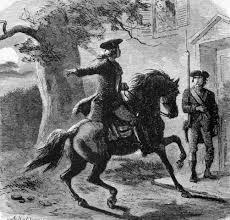 Listen, my children, and you shall hear
Listen, my children, and you shall hear
Of the midnight ride of Paul Revere,
On the eighteenth of April, in Seventy-Five:
Hardly a man is now alive
Who remem bers that famous day and year.
I couldn’t read until I was nine, so my mother bought me LPs (records) of poetry and music and, best of all, Richard Burton reading Dylan Thomas‘ Under Milk Wood – a play for voices – where I fell head over heels with the beauty of language. Later, the teenage me became captivated by the romantic image of the pale knight in John Keat‘s La Belle Dame Sans Merci.
O what can ail thee, knight-at-arms,
Alone and palely loitering?
The sedge has withered from the lake,
And no birds sing.
From the simple rhymes of childhood, to the moody stanzas of teens, I can’t think of a time when I wasn’t enchanted by verse – the sort that prods consciousness and provokes response, or the delicious resonance of thoughts and words like thick hot chocolate on the tongue.
Little fly
Thy summer’s play,
My thoughtless hand
Has brush’d away.
Am not I
A fly like thee?
Or art not thou
A man like me?
For I dance
And drink & sing;
Till some blind hand
Shall brush my wing.
If thought is life
And strength & breath;
And the want
Of thought is death;
Then am I
A happy fly,
If I live,
Or if I die.
William Blake
A school syllabus introduced me to Vernon Scannell. His war poem Walking Wounded provided a wealth of imagery. Simple images, powerful and persistent, such as: ‘In the rusty hedges pale rags of mist hung;’ In the piece ‘Nettles‘, he employs similar language in a more day-to-day – but equally touching – poem.
My son aged three fell in the nettle bed.
‘Bed’ seemed a curious name for those green spears,
That regiment of spite behind the shed:
It was no place for rest. With sobs and tears
The boy came seeking comfort and I saw
White blisters beaded on his tender skin.
We soothed him till his pain was not so raw.
At last he offered us a watery grin,
And then I took my billhook, honed the blade
And went outside and slashed in fury with it
Till not a nettle in that fierce parade
Stood upright any more. And then I lit
A funeral pyre to burn the fallen dead,
But in two weeks the busy sun and rain
Had called up tall recruits behind the shed:
My son would often feel sharp wounds again.
And when I became a teacher, I relished introducing children to the delights of poems such as Lone Dog.

I’m a lean dog, a keen dog, a wild dog and lone,
I’m a rough dog, a tough dog, hunting on my own!
I’m a bad dog, a mad dog, teasing silly sheep
I love to sit and bay the moon and keep fat souls from sleep.
Irene McLeod
For me, poetry touches the parts that no other art form can reach, and if I had to choose, then Life by George Herbert would rank as No.1

Beautiful posy of flowers from http://thenaturalweddingcompany.co.uk...
I made a posy, while the day ran by:
Here will I smell my remnant out, and tie
My life within this band.
But Time did beckon to the flowers, and they
By noon most cunningly did steal away,
And withered in my hand.
My hand was next to them, and then my heart;
I took, without more thinking, in good part
Time’s gentle admonition;
Who did so sweetly death’s sad taste convey,
Making my mind to smell my fatal day,
Yet, sug’ring the suspicion.
Farewell dear flowers, sweetly your time ye spent,
Fit, while ye lived, for smell or ornament,
And after death for cures.
I follow straight without complaints or grief,
Since, if my scent be good, I care not if
It be as short as yours.
September 8, 2017
Finding Titles: Tyger, Tyger.
 Finding titles for books can be quite a challenge. Many people turn to Shakespeare or the Bible for quotations, but for my Secret Of TheJournal series, poetry provided the inspiration.
Finding titles for books can be quite a challenge. Many people turn to Shakespeare or the Bible for quotations, but for my Secret Of TheJournal series, poetry provided the inspiration.
The strong historical links to the Seventeenth-century in the series had me hunting among my favourite Metaphysical poets: John Donne, George Herbert, and Andrew Marvell. Not only did Donne provide the titles for the first three books – Mortal Fire; Death Be Not Proud; and Rope of Sand, but his – and other poets – feature and is referenced throughout the series.
 I loved studying Metaphysical poetry at college. I enjoyed the subtlety of Donne and the self-deprecating piety of Herbert, while Marvell provided sly humour and memorable one-liners. In To His Coy Mistress, he manages to juggle a rather acidic, earthy remark, with one of sublime beauty, the latter made more poignant by its juxtaposition with the temporal subject of the poem.
I loved studying Metaphysical poetry at college. I enjoyed the subtlety of Donne and the self-deprecating piety of Herbert, while Marvell provided sly humour and memorable one-liners. In To His Coy Mistress, he manages to juggle a rather acidic, earthy remark, with one of sublime beauty, the latter made more poignant by its juxtaposition with the temporal subject of the poem.
‘My vegetable love should grow
Vaster than empires, and more slow;’
and
‘But at my back I always hear
Time’s wingèd chariot hurrying near;
And yonder all before us lie
Deserts of vast eternity.’
By book 4 – Realm of Darkness – I had moved through the centuries and found a quote in Longfellow to reflect Matthew’s development and change. How apt that Longfellow was also a resident of Portland, Maine, near where much of the story is set.
By the last book – Fearful Symmetry – I went back in time again, this time to William Blake, whose poetry often reflects a mind seeking answers in nature for the mysteries of heart and soul. Given Matthew’s unique status, it seemed fitting somehow, to finish with a poet who understood the sublime and divine in Creation.
Tyger, Tyger.
 Finding titles for books can be quite a challenge. Many people turn to Shakespeare or the Bible for quotes, but for my Secret Of TheJournal series, poetry provided the inspiration.
Finding titles for books can be quite a challenge. Many people turn to Shakespeare or the Bible for quotes, but for my Secret Of TheJournal series, poetry provided the inspiration.
The strong historical links to the Seventeenth-century in the series had me hunting among my favourite Metaphysical poets: John Donne, George Herbert, and Andrew Marvell. Not only did Donne provide the titles for the first three books – Mortal Fire; Death Be Not Proud; and Rope of Sand, but his – and other poets – feature and is referenced throughout the series.
 I loved studying Metaphysical poetry at college. I enjoyed the subtlety of Donne and the self-deprecating piety of Herbert, while Marvell provided sly humour and memorable one-liners. In To His Coy Mistress, he manages to juggle a rather acidic, earthy remark, with one of sublime beauty, the latter made more poignant by its juxtaposition with the temporal subject of the poem.
I loved studying Metaphysical poetry at college. I enjoyed the subtlety of Donne and the self-deprecating piety of Herbert, while Marvell provided sly humour and memorable one-liners. In To His Coy Mistress, he manages to juggle a rather acidic, earthy remark, with one of sublime beauty, the latter made more poignant by its juxtaposition with the temporal subject of the poem.
‘My vegetable love should grow
Vaster than empires, and more slow;’
and
‘But at my back I always hear
Time’s wingèd chariot hurrying near;
And yonder all before us lie
Deserts of vast eternity.’
By book 4 – Realm of Darkness – I had moved through the centuries and found a quote in Longfellow to reflect Matthew’s development and change. How apt that Longfellow was also a resident of Portland, Maine, near where much of the story is set.
 By the last book – Fearful Symmetry – I went back in time again, this time to William Blake, whose poetry often reflects a mind seeking answers in nature for the mysteries of heart and soul. Given Matthew’s unique status, it seemed fitting somehow, to finish with a poet who understood the sublime and divine in Creation.
By the last book – Fearful Symmetry – I went back in time again, this time to William Blake, whose poetry often reflects a mind seeking answers in nature for the mysteries of heart and soul. Given Matthew’s unique status, it seemed fitting somehow, to finish with a poet who understood the sublime and divine in Creation.
August 20, 2017
History In The Making: Abbotsbury & St Catherine’s Chapel
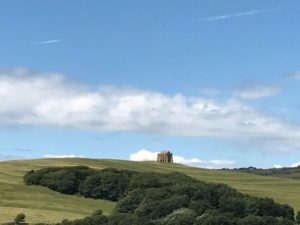 Sitting alone on the crest of a hill, St Catherine’s Chapel is one of only a few survivors like it left in the country. Fortress-like and sturdy, it overlooks Chesil Bank – that lethal stretch of shingle stretching fourteen miles from the Isle of Portland to Golden Cap – on which many a ship has founded. The seas are treacherous here. A strip of wild water known as the Portland Race, marks a current – once used by English sailors to defend our shores from Spanish invaders – that still catches sailors unawares. It is no surprise, then, that this late C14th chapel, built by masons employed by the nearby abbey of Abbotsbury and dedicated to St Catherine of Alexandria, was probably also used as a lighthouse and a warning beacon.
Sitting alone on the crest of a hill, St Catherine’s Chapel is one of only a few survivors like it left in the country. Fortress-like and sturdy, it overlooks Chesil Bank – that lethal stretch of shingle stretching fourteen miles from the Isle of Portland to Golden Cap – on which many a ship has founded. The seas are treacherous here. A strip of wild water known as the Portland Race, marks a current – once used by English sailors to defend our shores from Spanish invaders – that still catches sailors unawares. It is no surprise, then, that this late C14th chapel, built by masons employed by the nearby abbey of Abbotsbury and dedicated to St Catherine of Alexandria, was probably also used as a lighthouse and a warning beacon.
 Built entirely of the same golden limestone used in the abbey and village, the structure was built to withstand the ferocious storms that batter the Dorset coast. The stone roof drains water through gaps in the parapet, and heavy buttresses help support the stone-vaulted single space inside, where monks came to pray, and villagers made pilgrimage to the shrine of St Catherine.
Built entirely of the same golden limestone used in the abbey and village, the structure was built to withstand the ferocious storms that batter the Dorset coast. The stone roof drains water through gaps in the parapet, and heavy buttresses help support the stone-vaulted single space inside, where monks came to pray, and villagers made pilgrimage to the shrine of St Catherine.
 Now demure and plain, once it would have been highly decorated with richly coloured glass in the windows and painted statues in the niches by the altar.
Now demure and plain, once it would have been highly decorated with richly coloured glass in the windows and painted statues in the niches by the altar.
 Off the corner of the chapel, a stair turret rises to the parapet providing an oratory chapel and a space in which to light a brazier for a beacon. A tiny window looks west towards the sea, and two larger windows east to the abbey. Little remains, but even that which does, speaks of the veneration St Catherine earned in late Medieval society.
Off the corner of the chapel, a stair turret rises to the parapet providing an oratory chapel and a space in which to light a brazier for a beacon. A tiny window looks west towards the sea, and two larger windows east to the abbey. Little remains, but even that which does, speaks of the veneration St Catherine earned in late Medieval society.
Like so many others, the abbey fell victim to Henry VIII’s program of dissolution. However, the chapel had played an important part in village life for centuries, and local traditions developed around it. Perhaps the most notable was the trek up the hill to the chapel by women seeking a husband – my mother-in-law included. Balancing on one leg, the girl put a knee in one of the three holes in the south doorway, a hand in each of the others, whereupon she would pray:
St. Catherine, St. Catherine,
O lend me thy aid.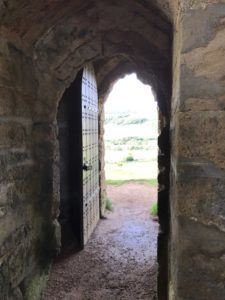
And grant that I never shall die an old maid.
A husband, St. Catherine,
A good one, St. Catherine.
But anyone’s better than no one, St. Catherine.
A husband, St. Catherine,
Young, St. Catherine,
Handsome, St. Catherine,
Kind, St. Catherine,
And soon, St. Catherine!
The girl would then stand, spin around three times on the spot, and clap her hands. And did the prayer work? It did for my mother-in-law. She met her future husband while on a picnic at the chapel.
Generations have come and gone, but St. Catherine’s Chapel remains an iconic feature of the landscape. Summer or winter, drive along the coast road from Bridport and you will be rewarded by one of the finest views in the South-West.

Photo: English Heritage
June 23, 2017
Birds of a Feather…
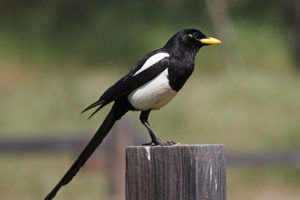 Passing through the Yorkshire Dales and close to the boarder with Lancashire, I spotted a couple of magpies on a stone barn roof having a conversation and a bit of a beak rub. At least I thought they were magpies. I did a double-take: no, no mistake – one of them had a bright yellow beak. We had driven on before I could whip out the camera and capture the creature. I thought it might be a mutation, but it wasn’t until I reached home and Googled it, that I was able to identify the chap. Without a doubt, and to my delight, it must have been a Yellow-Billed Magpie – restricted to the state of California in the United States, and inhabiting the Central Valley and foothills. For the first time in my life, I think I now understand the thrill of birdwatchers, and I’m going to wallow quite happily in my birdiness until someone comes along and bursts my bubble with a not-so-exciting alternative to my American migrant.
Passing through the Yorkshire Dales and close to the boarder with Lancashire, I spotted a couple of magpies on a stone barn roof having a conversation and a bit of a beak rub. At least I thought they were magpies. I did a double-take: no, no mistake – one of them had a bright yellow beak. We had driven on before I could whip out the camera and capture the creature. I thought it might be a mutation, but it wasn’t until I reached home and Googled it, that I was able to identify the chap. Without a doubt, and to my delight, it must have been a Yellow-Billed Magpie – restricted to the state of California in the United States, and inhabiting the Central Valley and foothills. For the first time in my life, I think I now understand the thrill of birdwatchers, and I’m going to wallow quite happily in my birdiness until someone comes along and bursts my bubble with a not-so-exciting alternative to my American migrant.
Image from Audubon.
February 16, 2017
Publishers Weekly Book Review: Fearful Symmetry
‘English author Dunn completes his Secret of the Journal series with this stunning fifth and final volume.’
 Delighted to see this review of Fearful Symmetry in Publishers Weekly. Although I have mysteriously become a man (well, I do publish as C.F.Dunn, so they weren’t to know) I’m really pleased to see the reviewer has enjoyed the final instalment in The Secret Of The Journal series. There are lots of spoilers, though, so if you haven’t read Fearful Symmetry yet, don’t read the detailed review.
Delighted to see this review of Fearful Symmetry in Publishers Weekly. Although I have mysteriously become a man (well, I do publish as C.F.Dunn, so they weren’t to know) I’m really pleased to see the reviewer has enjoyed the final instalment in The Secret Of The Journal series. There are lots of spoilers, though, so if you haven’t read Fearful Symmetry yet, don’t read the detailed review.
http://www.publishersweekly.com/978-1-78264-198-8



